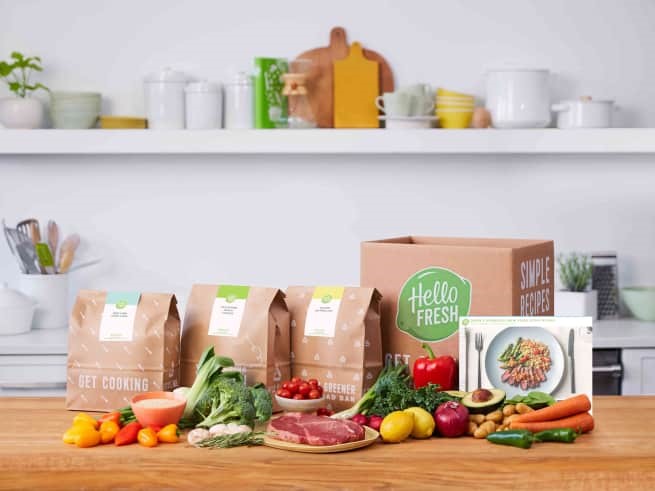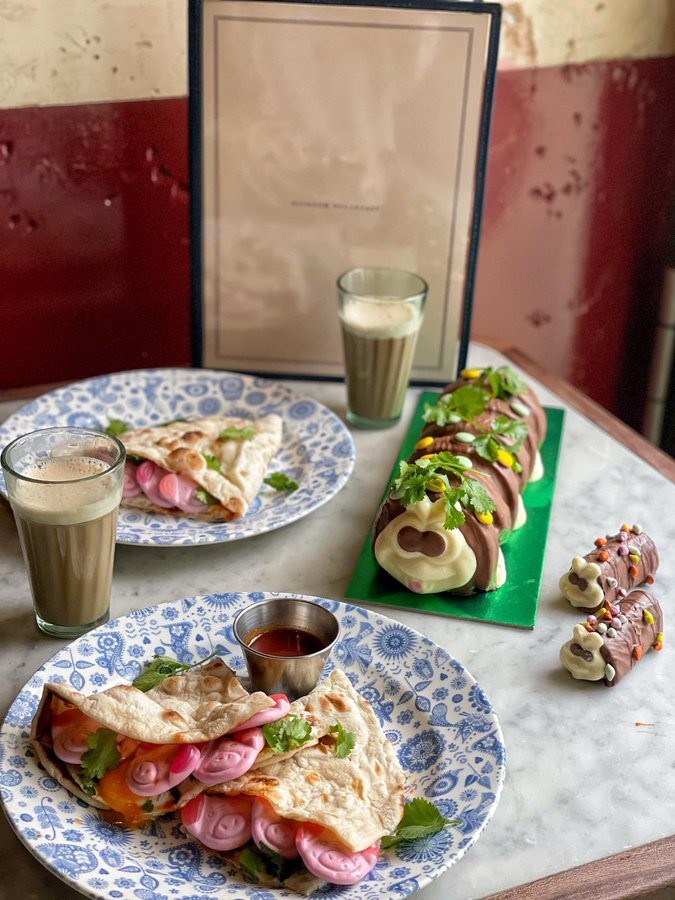Sales of groceries in the UK have risen significantly during the pandemic, as reported by Public Health England[1]. According to Premier Food’s Kitchen Cooking Index[2], a third of UK households have added a new dish to their “go-to” evening meals since the pandemic, with more than 91% of people intending to do the same amount of cooking, or more, in the year ahead.
A way to introduce variety and excitement into our lives, the lockdown lifestyle has brought about a rise in sales of curry pastes, powders and condiments in particular. Increased time at home has also accelerated a move away from ready meals and pizzas[3], although demand for plant-based ready meals has risen[4]. Conscious of the environmental impact of what we eat, a survey by YouGov[5] has also found that more than half of us are now using freezers to store batch-cooked food and reduce food waste.
The recipe revolution: subscription services and at-home cooking kits gain further popularity
Recipe meal kits, which provide fresh ingredients and all the necessary seasonings and condiments pre-portioned with accompanying recipes, have experienced a boom during the pandemic. Subscription services such as Hello Fresh, Gousto, Mindful Chef and Pasta Evangelists all provide such kits. Compared with the previous year, Hello Fresh saw a 74.2% increase in active users globally in the first three months of 2021[6], reporting new consumer habits and increased interest in using meal kits compared with supermarket shopping for separate ingredients. Fresh pasta rival Pasta Evangelists has estimated an increase of sales of more than 300% in 2020[7].

Source: https://www.hellofresh.com/eat/meal-kits-for-singles
Morrisons’ EatFresh box and the M&S Recipe Box were also launched during lockdown, suggesting supermarkets were also keen to jump on this growing bandwagon. These have however now been discontinued, perhaps due to the logistical challenges of offering fresh recipe kits.
Big players in the food & drink industry are also taking part, with Nestlé having acquired Simply Cook earlier this year, bolstering its direct to consumer offerings in the UK[8]. Simply Cook’s kits include pre-portioned blends of herbs and spices combined with easy to follow recipes, to accompany separately purchased fresh ingredients.
Respecting recipes: establishing intellectual property rights in the food & drink sector
With recipe repertoires growing, and an increased trend for buying recipe kits, intellectual property is of ever-increasing importance in the food industry.
In today’s climate of unique culinary creations, recipes are a valuable business asset, not least for companies offering recipe subscription kits[9]. But how can recipes be protected, and how can different types of intellectual property rights be established in this part of the food & drink sector?
Can you keep a (trade) secret?
Mysteriously containing eleven secret herbs and spices, KFC’s fried chicken recipe is famously protected as a trade secret, as are other world-famous assets such as the Coca-Cola recipe.
Trade secrets can be effective if a recipe is strictly kept confidential, though there is always the potential risk of reverse engineering by third parties. Trade secrets can also be difficult to rely on, because it could be difficult to discern whether an alleged infringer has copied a recipe, or just relied on trial and error to come up with something similar.
This is particularly the case for recipes such as restaurant dishes which may be easier to reverse engineer than the chemical formulation of a homogeneous item such as a fizzy drink.
Delicious trade marks
Recipes and their associated products can also be marketed under distinctive names (think McDonalds’ “Big Mac” or Burger King’s “Whopper”) or through distinctive shapes (think the Oreo biscuit) which can then be protected by trade marks. Nusret Gökçe, nicknamed in the industry as “Salt Bae”, has even succeeded in registering a motion trade mark in the EU for his viral 2017 video of him sprinkling salt over meat[10]. Brand owners can then stop competitors if there is a likelihood of confusion with their trade mark, or if the earlier trade mark has a reputation and there is an element of unfair advantage or detriment in what the competitor is doing.
In the UK and other common law countries, it’s also possible to build up enforceable rights in a name or product get-up through use of these signs in trade, known as “passing off” rights. These can be harder to rely on than a registered trade mark, however, as a) the claimant needs to prove the existence of such rights (without the benefit of a clear-cut trade mark registration certificate) and b) the courts require there to be an element of confusion or misrepresentation which is not always present if consumers wouldn’t actually be confused between the two offerings.
Most countries in the EU have a law of unfair competition rather than passing off. This varies by country in terms of what it will protect, but it doesn’t generally require the same element of confusion or misrepresentation as passing off - making it a potentially more fruitful ground for a challenge in some cases.
Bring home the bacon: recent IP disputes in the food & drink sector
The last few years have seen some high-profile IP disputes in the food & drink sector, many involving leading brands versus discount supermarkets. For example, M&S hit the headlines in 2021 when it accused Aldi’s “Cuthbert the Caterpillar” cake of infringing its “Colin the Caterpillar” trade mark.
Restaurant chain Dishoom later hit out at M&S for allegedly using the recipe for its signature chilli egg and bacon naan roll[11], which they also offer as an at-home recipe kit. M&S shared a photograph of a chilli egg and bacon naan roll on its Instagram with an accompanying recipe and how-to video tutorial.
After an exchange on Twitter which included Dishoom drumming up their own alternative version of the naan stuffed with M&S’ signature Percy Pig sweets, M&S eventually credited Dishoom as their inspiration on Instagram, but the chain later discovered their recipe was being used elsewhere without similar acknowledgement[12]. It also emerged that M&S had been making money out of the recipe through various paid advertising platforms[13].
So, what can be done to protect recipes that are already out in the public domain (i.e. which can no longer be protected as trade secrets), such as those posted on blogs and printed with recipe kits?

|
Source: https://www.timeout.com/london/news/m-s-criticised-by-dishoom-for-their-somewhat-familiar-bacon-naan-recipe-070521
|
Cooking up a storm: copyright for culinary creations
Specific literary expressions of recipes and accompanying photographs can be protected by copyright, as for other written works and photographs. However, copyright in a recipe as a literary work would allow you to stop people only from replicating the recipe in that particular form – i.e. it would only protect against republication of the written recipe itself, but not against copying of the actual edible output thereof. Such rights don’t relate to the recipe itself and copyright in a specific expression of a recipe in a cookbook doesn’t protect against a restaurant copying the recipe and putting the dish on their own menu. So, what about the specific combination and quantities of ingredients and the cooking steps?
Can you patent a recipe?
There is no explicit exclusion for the subject matter of recipes under the UK Patents Act or the European Patent Convention per se, although patent protection is rarely obtained for certain recipes, due to difficulties in demonstrating the requisite novelty and inventive step. No matter how unique and ground-breaking a chef might claim their concoction to be, most recipes are simply different combinations of known ingredients that come together without an unexpected technical effect.
But it’s not impossible – patents have been granted at the EPO for meat replica compositions[14] amongst other foodstuffs, though such subject-matter typically relates to the composition of ingredients used in food manufacturing, rather than to recipes for cooking at home or in restaurants per se. In the UK, a patent was also granted for a fish and chip batter which was found to be inventive because it reduces oil uptake during the frying process[15].
Of course, patent protection can also still be obtained for other aspects relating to recipes or ingredients, such as manufacturing or processing methods, and packaging – so there is still plenty businesses can do to protect their edible innovations.
What’s next for the recipe revolution?
A good recipe starts with the right balance of ingredients. Equally, a successful IP strategy will balance your immediate commercial goals with long-term protection of your IP. We’re here to give commercially focused, no-nonsense advice, not to spoon-feed you information – so you can find the right mix of protection for your IP.
The food & drink sector has quickly evolved, taking advantage of and fast-tracking developments which were in some cases already in the pipeline. There is a huge opportunity for the sector to tune in to and take advantage of changing consumer trends resulting from working-from-home and increased interest in easy, healthy, low-waste meals. If you’re a food & drink business, your intellectual property needs to work harder for you than ever before – but the potential rewards are greater than ever.
If you would like to know more and find out how we might be able to help your food & drink business, please get in touch. We would love to be part of your journey. But more than that, we understand your sector. Against the commercial backdrop which is already familiar to us, we work hard to get to know your business and its own individual needs, providing tailored, pragmatic advice and building a genuine partnership.
If you have any questions, please get in touch with Katy, or your usual Kilburn & Strode advisor.
[1] https://assets.publishing.service.gov.uk/government/uploads/system/uploads/attachment_data/file/932350/Grocery_Purchasing_Report.pdf
[2] https://www.premierfoods.co.uk/CorporateSite/media/documents/media/Premier-Foods-Kitchen-Cooking-Index-February-2021.pdf
[3] https://www.thegrocer.co.uk/category-reports/has-covid-finished-off-ready-meals-ready-meals-and-soups-category-report-2021/651924.article
[4] https://www.sciencedirect.com/science/article/pii/S0924224421001035
[5] https://www.premierfoods.co.uk/Media/Latest-News-Stories/News-2021/What%E2%80%99s-cooking-91-of-Brits-intend-to-cook-as-muc.aspx
[6] https://www.bbc.co.uk/news/business-56977643
[7] https://www.bbc.co.uk/news/business-56977643
[8] https://www.nestle.co.uk/en-gb/media/pressreleases/allpressreleases/nestle-acquire-uk-based-recipe-company-simplycook
[9] https://www.lexology.com/library/detail.aspx?g=3741a5c0-f146-40ab-8f74-21427cd3b673
[10] https://ipkitten.blogspot.com/2018/11/3-second-cinematic-sequence.html
[11] https://www.independent.co.uk/life-style/food-and-drink/marks-spencer-dishoom-instagram-recipe-b1874568.html
[12] https://www.timeout.com/london/news/m-s-criticised-by-dishoom-for-their-somewhat-familiar-bacon-naan-recipe-070521
[13] https://foodtribe.com/p/ms-nicked-the-recipe-for-dishooms-QXqk80urShGfUUb_pSX3jw?iid=Oofd8RXAT4qH4s2Ui8T-fg
[14] https://worldwide.espacenet.com/publicationDetails/claims?CC=EP&NR=3125699B1&KC=B1&FT=D&ND=4&date=20190821&DB=&locale=en_EP
[15] https://worldwide.espacenet.com/publicationDetails/claims?CC=GB&NR=2543623B&KC=B&FT=D&ND=4&date=20171108&DB=&locale=en_EP